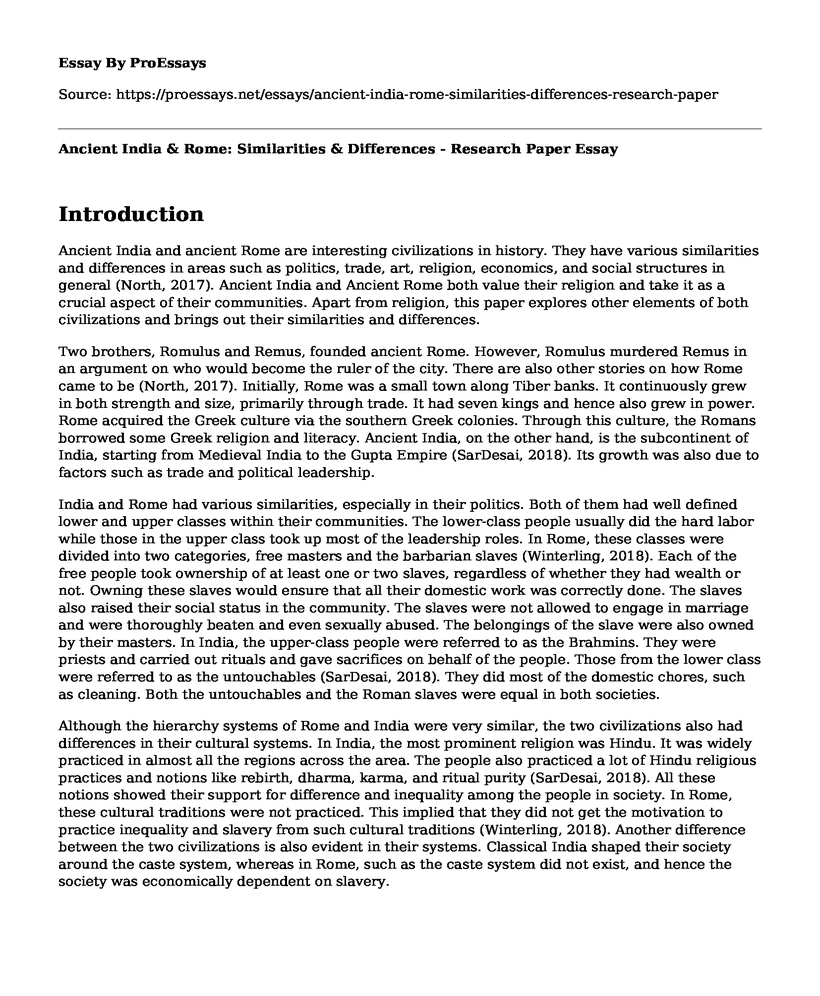Introduction
Ancient India and ancient Rome are interesting civilizations in history. They have various similarities and differences in areas such as politics, trade, art, religion, economics, and social structures in general (North, 2017). Ancient India and Ancient Rome both value their religion and take it as a crucial aspect of their communities. Apart from religion, this paper explores other elements of both civilizations and brings out their similarities and differences.
Two brothers, Romulus and Remus, founded ancient Rome. However, Romulus murdered Remus in an argument on who would become the ruler of the city. There are also other stories on how Rome came to be (North, 2017). Initially, Rome was a small town along Tiber banks. It continuously grew in both strength and size, primarily through trade. It had seven kings and hence also grew in power. Rome acquired the Greek culture via the southern Greek colonies. Through this culture, the Romans borrowed some Greek religion and literacy. Ancient India, on the other hand, is the subcontinent of India, starting from Medieval India to the Gupta Empire (SarDesai, 2018). Its growth was also due to factors such as trade and political leadership.
India and Rome had various similarities, especially in their politics. Both of them had well defined lower and upper classes within their communities. The lower-class people usually did the hard labor while those in the upper class took up most of the leadership roles. In Rome, these classes were divided into two categories, free masters and the barbarian slaves (Winterling, 2018). Each of the free people took ownership of at least one or two slaves, regardless of whether they had wealth or not. Owning these slaves would ensure that all their domestic work was correctly done. The slaves also raised their social status in the community. The slaves were not allowed to engage in marriage and were thoroughly beaten and even sexually abused. The belongings of the slave were also owned by their masters. In India, the upper-class people were referred to as the Brahmins. They were priests and carried out rituals and gave sacrifices on behalf of the people. Those from the lower class were referred to as the untouchables (SarDesai, 2018). They did most of the domestic chores, such as cleaning. Both the untouchables and the Roman slaves were equal in both societies.
Although the hierarchy systems of Rome and India were very similar, the two civilizations also had differences in their cultural systems. In India, the most prominent religion was Hindu. It was widely practiced in almost all the regions across the area. The people also practiced a lot of Hindu religious practices and notions like rebirth, dharma, karma, and ritual purity (SarDesai, 2018). All these notions showed their support for difference and inequality among the people in society. In Rome, these cultural traditions were not practiced. This implied that they did not get the motivation to practice inequality and slavery from such cultural traditions (Winterling, 2018). Another difference between the two civilizations is also evident in their systems. Classical India shaped their society around the caste system, whereas in Rome, such as the caste system did not exist, and hence the society was economically dependent on slavery.
Conclusion
In conclusion, both ancient Rome and ancient India had various similarities and differences. They both had similar social hierarchy systems, especially in terms of their political operations and interactions. However, they had differences in terms of their religion, which significantly contributed to their economic growth.
References
North, J. A. (2017). Ancient History Today. A Companion to Ancient History, 87-98. doi: 10.1002/9781444308372.ch9
SarDesai, D. R. (2018). State and Politics in Ancient India. India, 65-86. doi:10.4324/9780429499876-5
Winterling, A. (2018). Imperial Madness in Ancient Rome. Oxford Scholarship Online. doi:10.1093/oso/9780199394852.003.0005
Cite this page
Ancient India & Rome: Similarities & Differences - Research Paper. (2023, Apr 28). Retrieved from https://proessays.net/essays/ancient-india-rome-similarities-differences-research-paper
If you are the original author of this essay and no longer wish to have it published on the ProEssays website, please click below to request its removal:
- The Theme of Identity Essay
- Research Paper on Diversity of the Contemporary Families
- Essay Sample on Industrial Revolution: Impact on Modern Society
- The Significance of Marriage and Family in Society - Essay Sample
- Essay on The Golden Age of Greece: Humanism, Literature & Philosophy
- Essay Sample on The Rise and Growth of Slavery: Its Impact on Africa
- Paper Example on Native Americans Face Homelessness: The Story of Jackson Jackson







